

| From Pushy Cat To Powered Parachutes! |
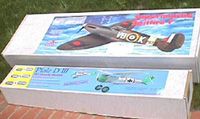 Well
here we are again. Another month has passed and here is my latest stab
at an article covering different aspects of electric flight, which is
my major interest now and, I believe, the future of model flying.
Well
here we are again. Another month has passed and here is my latest stab
at an article covering different aspects of electric flight, which is
my major interest now and, I believe, the future of model flying.
I have been working away a lot again this month so I have not had as much time to fly as I would have liked, but that does not stop my brain working overtime on modelling matters, ideas and creations.
 Firstly
a taste of what is to come in the next article or two. I have just acquired
another two kits which I hope to have built and flown by the next article.
These are both foam kits, one a slow fly Pfalz and one a not quite so
slow Spitfire - my thanks to Richard Haywood for having a clearout which
I just could not resist. Pictures give you a taste of what is forthcoming.
Firstly
a taste of what is to come in the next article or two. I have just acquired
another two kits which I hope to have built and flown by the next article.
These are both foam kits, one a slow fly Pfalz and one a not quite so
slow Spitfire - my thanks to Richard Haywood for having a clearout which
I just could not resist. Pictures give you a taste of what is forthcoming.
Thanks also to Tony, the boss at a project in Cardiff I have been working
on last week, who brought me a Skyflex in on the last day - Tony has ordered
a Picolo from me - very nice!
Updates
The Pushy Cat from the last article has now had its' main wing angle
of incidence reduced from "Way too much" to "Just about
right" - or 2 degrees for the technical ones out there - and flies
just fine.
The Jiant Jabberwock is all ready to fly now with it's Quad Sport motor, twin speed controllers and 36x2000 mAh cells so hopefully I can report on this soon as well.
Radio Queen - what can I say - just complete pleasure.
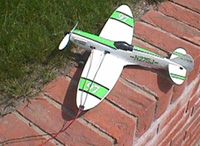
 The
Cox Electric Control Line Spitfire is now flying - in my back garden.
I resolved my battery problem when I spotted a set of Cox Control Line
handles and wires for electric control line'ers on eBay. There have arrived
from America and after a slight modification to the Spit and the wires
I am now flying. The battery pack attaches to the handle (just drop the
pack in your pocket) and the power goes up the lines. This works great
but I seem to have forgotten the art of control line flying!
The
Cox Electric Control Line Spitfire is now flying - in my back garden.
I resolved my battery problem when I spotted a set of Cox Control Line
handles and wires for electric control line'ers on eBay. There have arrived
from America and after a slight modification to the Spit and the wires
I am now flying. The battery pack attaches to the handle (just drop the
pack in your pocket) and the power goes up the lines. This works great
but I seem to have forgotten the art of control line flying!
The Spitfire flies on 10 foot lines and does so beautifully, but when
I land I seem to have this falling over problem! It is keeping everyone
very amused at the moment but I'm sure I will get the knack.
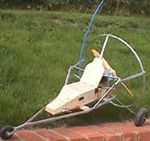 Current
Project
Current
Project
This month I have been working on the Powered Parachute which I mentioned
in my previous article.
I have made this predominately from 1/8" aluminium for lightness
strength and resilience.
If this is successful, and I don't see at this stage why it should not
be then I will be kitting this, probably as an ARTF or even RTF model.
It uses an 88" parafoil canopy made of rip-stop nylon and is powered
by a Team Gear Sport Twin Unit.
The batteries (14 cells) are held in a light ply box supported on the main framework. The radio gear - RX, RX battery and 2 servos are fitted on top of this box, with the speed controller at a lower level at the front.
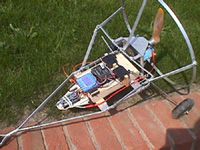
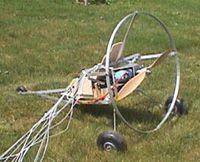 A
light ply seat assembly fits over all of this to hide everything a give
a look of authenticity. The seat is yet to be finished in a leatherette
covering to really look the part - just missing Action Man I think!
A
light ply seat assembly fits over all of this to hide everything a give
a look of authenticity. The seat is yet to be finished in a leatherette
covering to really look the part - just missing Action Man I think!
The Team Gear unit is built in to act as part of the airframe, rear mounted and at the moment having a standard 12x10 Master Airscrew prop with the motors spinning the opposite way to usual - obviously a pusher prop would be favourable but I don't have one yet. The parafoil is fixed to the out riggers on either side in line with the units centre of gravity.
The steering lines come through eyes next to these fixing points and attach to the extended servo arms. Basically if the left servo pulls it goes left and vice versa. If both pull it flares the canopy to loose height. Computer radio sorts all of this out for you with a little jiggery-pokery.
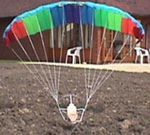 Engine
power is used to climb and descend and that's it! Should be really easy
to fly and control and I hope that in a reasonable breeze it will hover.
Engine
power is used to climb and descend and that's it! Should be really easy
to fly and control and I hope that in a reasonable breeze it will hover.
This should be the ideal aerial photo machine as it should be able to
take a reasonable payload and with electric power and the ability to hover
there is no vibration to worry about.
I have been approached by a UK firm who are about to release a new Colour Video transmitted designed specially for models and although I am not in a position to purchase one myself (although they will only be about £250 for a set - TX, RX Camera etc.) I have offered to review one for them in these articles and fingers crossed I will be able to bring you news of this in future articles.
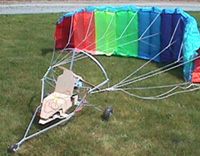 The
unit is now ready to go for its maiden voyage, the difficult part will
be getting the control lines just right so that the servos do their job.
The
unit is now ready to go for its maiden voyage, the difficult part will
be getting the control lines just right so that the servos do their job.
The centre vents in the parafoil may also have to be sealed (a tip I discovered
whilst researching this - to help stability) and a short rod built into
the parafoil at the control lines points may also help.
All of these will be tried and my results and hopefully more pics of it in the air will come next month. If it is successful then it will go into production straight away, each unit will be built, set-up and test flown before they go out and will be complete with a Team Gear Sport Twin with the complete package option also available.
That's about it for this month, thanks again for reading my articles. If I can be of any assistance then please get in touch. E-mail is the safest way due to the amount of time I spend on line in the evenings.
Happy flying and here's hoping for some good weather this month to get all of our projects in the air.
As I said previously, if you are a supplier or manufacturer of anything to do with electric flight and you would like me to review it in this column then please get in touch.
If you have any questions then please get in touch with
Mark at:
ratby@bizonline.co.uk
or check out his web site at:
www.bizonline.co.uk/ratbyaeroplanes